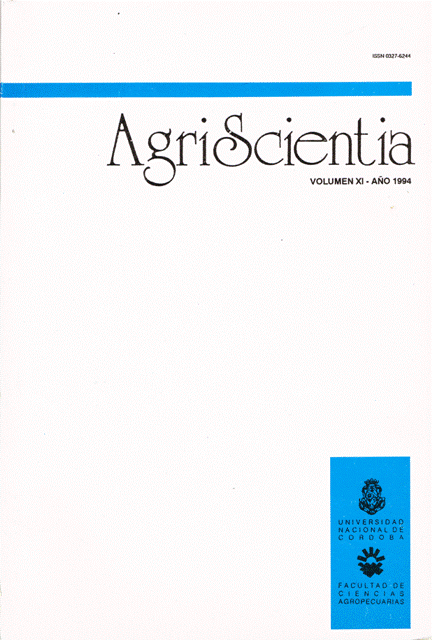Evaluation of the in vitro dedifferentiation and redifferentiation capacity of four genotypes of Lycopersicon esculentum Mill
Main Article Content
Abstract
Four Lycopersicon esculentum genotypes—Planeuco INTA, Rossol Selección La Consulta, Cal J, and Raci 53—were evaluated to produce callus and further regeneration. Folioli were used as explants. The basal medium for callus production was MS with different concentrations of plant regulators: ANA 2 mg·L⁻¹ + BAP 1 mg·L⁻¹ (MI) and ANA 1 mg·L⁻¹ + BAP 0.5 mg·L⁻¹ (MII). The genotypes were analyzed under two environmental conditions: light and darkness. Regeneration media was the same but with different concentrations of plant regulators: AIA 0.175 mg·L⁻¹ + BAP 2.25 mg·L⁻¹ (MA) and AIA 0.175 mg·L⁻¹ + BAP 4.50 mg·L⁻¹ (MB). Callus percentage was evaluated after 30 days from in vitro culture. The percentage of redifferentiation was low and depended on the previous conditions they were exposed to.
Article Details

This work is licensed under a Creative Commons Attribution-ShareAlike 4.0 International License.
How to Cite
References
Dale, P.J. and E. Deambrogio, 1979. A comparison of callus induction and plant regeneration from different explants of Hordeum vulgare. Z. Pflanzenzuecht 94: 65-77.
Komatsuda, T.; S. Enomoto and K. Nakajima, 1989. Genetics of callus proliferation and shoot differentiation in barley. J. of Heredity 80(5): 345-350.
Larkin, P.S. and W.R. Scowcroft, 1982. Somaclonal variation: A new option for plant improvement. Theor. Appl. Genet. 60: 197.
Locky, R.D., 1983. Callus formation and organogenesis by explants of six Lycopersicon species. Can. J. Bot. 61: 1072-1079.
Maddock, S.F.; V.A. Lancaster; R. Risiott and J. Franklin, 1983. Plant regeneration from cultured immature embryo and inflorescence of 25 cultivars of wheat (Triticum aestivum). J. Exp. Bot. 34: 915-926.
Mok, M.C.; D.W.S. Mok; D.J. Armstrong; A. Rabakoarihanta and S.G. Kim, 1980. Cytokinin autonomy in tissue cultures of Phaseolus: a genotype-specific and heritable trait. Genetics 94: 675-686.
Murashige, T. and F. Skoog, 1962. A revised medium for rapid growth and bioassays with tobacco tissue cultures. Physiol. Plant. 15: 473-497.
Reinert, B. and E. Bingham, 1968. Control of totipotency in plant cells growing in vitro. Nature (Lond.) 220: 1340-1441.
Reisch, B. and E. Bingham, 1980. The genetic control of bud formation from callus cultures of diploid alfalfa. Plant Sci. Lett. 20: 71-77.
Rines, H.W. and T.J. McCoy, 1981. Tissue culture initiation and plant regeneration in hexaploid species of oats. Crop Sci. 21: 837-842.
Sahondra, R.R.; G. Alibert and C. Planchon, 1990. Continuous plant regeneration from established embryogenic cell suspension cultures of Italian ryegrass and tall fescue. Plant Breeding 104: 265-271.
Sokal, R.R. y F.S. Rohlf, 1969. Biometría. W.H. Freeman, San Francisco.
Tatchell, S. and A. Binns, 1986. A modified Murashige and Skoog media for regeneration of direct explants and long-term callus cultures of tomato. Tomato Genet. Coop. Rep. 36: 35-36.
Vasil, V. and I.K. Vasil, 1986. Plant regeneration from friable embryogenic callus and cell suspension cultures of Zea mays L. J. Plant Physiol. 124: 399-408.
Zorzoli, R.; E.L. Cointry; E.A. Prado; L.A. Mroginski y L.A. Picardi, 1988. Regeneración de plantas de tomate (Lycopersicon esculentum) por cultivo in vitro de folíolos. Turrialba 38(4): 332-336.
Zorzoli, R.; M. Mitidieri; G.M. Nestares y L.A. Picardi, 1991. Formación de vástagos in vitro con tres tejidos de tomate (Lycopersicon esculentum Mill.) a lo largo de sucesivos ciclos de regeneración. Rev. Agron. N.O. Argent. XXVI(1-2): 5-17.





